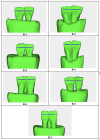Comparative evaluation of the performance of orthodontic retainers using different surface protocols: an in vitro study
- PMID: 39945873
- PMCID: PMC11825553
- DOI: 10.1007/s10103-025-04348-4
Comparative evaluation of the performance of orthodontic retainers using different surface protocols: an in vitro study
Abstract
This study aims to assess the in vitro durability of Nitinol retainers, manufactured using computer-aided methods with hydrophilic or superhydrophilic surfaces to reduce debonding, alongside a commonly used composite adhesive. The 112 lower incisor teeth were embedded in blocks in pairs. Retainer wires were made up of 0.018 × 0.018 inch Nickel Titanium alloy(G4™ Nickel Titanium G&H Orthodontics, USA) by bending a robot arm. A total of 16 teeth(8 blocks) were used for each of the mentioned 7 groups Ni-Ti Retainer; Laser Textured Ni-Ti Retainer; Laser Texturing and Atmospheric Plasma Applicated Ni-Ti Retainer; Atmospheric Plasma Applicated Ni-Ti Retainer; Laser Texturing and Atmospheric Plasma Applicated Ni-Ti Retainer*2; Laser Texturing and Atmospheric Plasma Applicated Ni-Ti Retainer*3; SS-0.0018"(Morelli, Brazil). Transbond LR(3 M Unitek, California) was used. The shear bond strength tests were conducted. The Kruskal-Wallis H test was employed, pairwise comparisons followed by Dunn's test with Bonferroni correction as a post-hoc analysis. There was no statistically significant difference between the groups for maximum force and maximum stress(p > 0.05). However, a significant difference was found in maximum elongation (p:0.0023). Pairwise comparisons highlighted significantly higher elongation values in the SS-0.0018" group. The stainless-steel wire demonstrated higher elongation values, which may offer clinical advantages in cases with higher occlusal forces and periodontal problems due to its material flexibility. Laser Texturing and Atmospheric Plasma Applied Ni-Ti Retainers exhibited higher test performance. Surface treatments applied to CAD/CAM retainers can provide an advantage by enhancing bond strength, potentially reducing the risk of debonding. These findings underline the importance of material selection and surface treatments in optimizing fixed retention strategies for long-term clinical success.
Keywords: Atmospheric plasma; Computer-aided design/computer-aided manufacturing; Fixed lingual retainers; Laser surface texturing; Permanent retantion.
© 2025. The Author(s).
Conflict of interest statement
Declarations. Ethical approval: Here is the English translation of the consent form from Orginal language. Prior to participation, all individuals provided written informed consent after being fully informed about the study’s purpose, procedures, and potential risks. Participation was entirely voluntary, and individuals retained the right to withdraw at any point without penalty. Consent for publication: Not applicable. Competing interests: The authors declare no competing interests.
Figures




Similar articles
-
Comparison of six different CAD/CAM retainers vs. the stainless steel twistflex retainer: an in vitro investigation of survival rate and stability.J Orofac Orthop. 2025 Mar;86(2):119-128. doi: 10.1007/s00056-023-00486-y. Epub 2023 Jun 28. J Orofac Orthop. 2025. PMID: 37378840 Free PMC article.
-
Different Wire Surface Treatments on Adhesion Efficacy of Orthodontic Fixed Retainer: An In Vitro Study.J Contemp Dent Pract. 2024 Jul 1;25(7):677-683. doi: 10.5005/jp-journals-10024-3726. J Contemp Dent Pract. 2024. PMID: 39533939
-
Antibacterial activity and debonding force of different lingual retainers bonded with conventional composite and nanoparticle containing composite: An in vitro study.J World Fed Orthod. 2020 Jun;9(2):80-85. doi: 10.1016/j.ejwf.2020.03.001. Epub 2020 Apr 17. J World Fed Orthod. 2020. PMID: 32672659
-
Efficacy of CAD/CAM Technology in Interventions Implemented in Orthodontics: A Scoping Review of Clinical Trials.Biomed Res Int. 2022 Jun 2;2022:5310555. doi: 10.1155/2022/5310555. eCollection 2022. Biomed Res Int. 2022. PMID: 35692590 Free PMC article.
-
Transforming orthodontic retention: potential of 3D printing and biocompatible material characteristics.J Med Eng Technol. 2025 Jan;49(1):8-33. doi: 10.1080/03091902.2025.2466198. Epub 2025 Feb 20. J Med Eng Technol. 2025. PMID: 39976311 Review.
Cited by
-
Comparison of survival rate and duration of maxillary and mandibular lingual bonded retainers - a retrospective cohort study.BMC Oral Health. 2025 Jul 2;25(1):1048. doi: 10.1186/s12903-025-06314-6. BMC Oral Health. 2025. PMID: 40604851 Free PMC article.
References
-
- Reitan K (1969) Principles of retention and avoidance of posttreatment relapse. Am J Orthod 55(6):776–790. 10.1016/0002-9416(69)90050-5 - PubMed
-
- Proffit WR, Fields HW, Sarver DM (2006) Contemporary orthodontics. Elsevier Health Sciences, Philadelphia, USA
-
- Almuqbil S, Banabilh S (2019) Postretention phase: patients’ compliance and reasons for noncompliance with removable retainers. Int J Orthod Rehabil 10:18–22. 10.4103/ijor.ijor
-
- Zachrisson BU (1977) Clinical experience with direct-bonded orthodontic retainers. Am J Orthod Dentofac Orthop 71:440–448. 10.1016/0002-9416(77)90247-0 - PubMed
Publication types
MeSH terms
Substances
LinkOut - more resources
Full Text Sources
Miscellaneous

